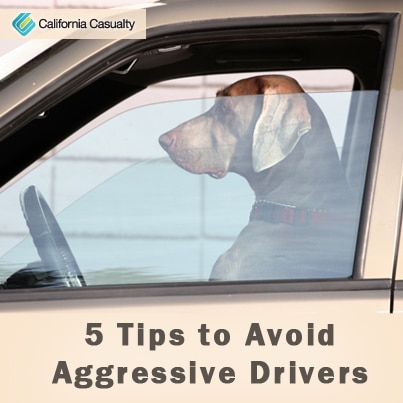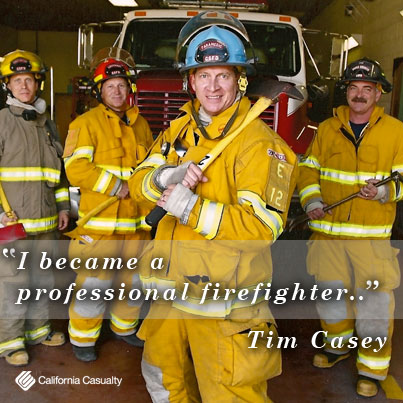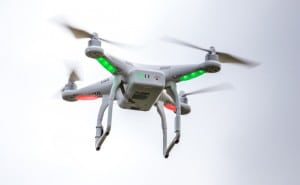by California Casualty | Safety |

By: Mark Goldberg
I couldn’t believe it (well, then again nothing is that surprising these days) – the guy in the car ahead of me was shaving. It was early morning as we drove on a narrow two-lane road. He swerved numerous times as he continued grooming behind the wheel. It could have ended badly since there were school buses and elementary school children on the side of the road; luckily nobody was hit or hurt. The sad part is that he was oblivious to how dangerous his antics were.
Then, on a recent trip to visit our daughter, my wife and I witnessed drivers passing on the far right on the interstate, wildly veering across three lanes and then back to the left lane. Others were tailgating at such a high speed that there was no way they would avoid slamming into the car ahead if traffic suddenly came to a stop.
We’ve all seen it; people with angry faces, often gesturing, as the careen through our thoroughfares as if they were the only one who mattered. As we encounter the growing number of distracted and aggressive drivers, it got me thinking about how we all need to be hyper-aware and drive with extra precaution.

So, what can you do?
- Stay out of the left lane unless you are passing
- Don’t challenge them by speeding up or trying to block them
- Follow the speed limit
- Avoid eye contact
- Report them to authorities providing vehicle description, license plate number, location and direction of travel
Gesturing back or making eye contact can often lead to road rage.
And here are some defensive driving tips that can help you avoid confrontations with aggressive drivers:
- Keep scanning the area ahead and behind you
- Drive with both hands on the wheel to better respond to dangers
- Wear your seatbelt
- Slow down in bad weather
- Have an escape plan
- Don’t follow too close
- Avoid driving when tired or drowsy
Experts recommend that you take a defensive driving course to learn these techniques; besides it can also qualify you for a discount on your auto insurance.
California Casualty is dedicated to preventing this type of driving behavior. That’s why we are proud to be a major sponsor of Impact Teen Drivers, a nonprofit formed with the law enforcement and education groups that uses peer-to-peer tactics to educate teen and young adults about the dangers of distracted and reckless driving. Learn more at https://www.calcas.com/web/ccmc/impact-teen-drivers.
Before you hit the road, make sure you have adequate protection in case you encounter a distracted or aggressive driver. Call a California Casualty advisor today for an auto policy review or comparison at 1.800.800.9410 or visit www.calcas.com.
Sources for this article:
https://www.nhtsa.gov/people/injury/aggressive/Aggressive%20Web/index.html
https://www.nhtsa.gov/people/injury/enforce/aggdrv.html
https://auto.howstuffworks.com/car-driving-safety/accidents-hazardous-conditions/10-safe-driving-tips.htm#page=9
https://www.distraction.gov/
https://roadragers.com/road-rage-advice.htm
by California Casualty | Firefighters |

Tim Casey describes himself as, “a retired firefighter/paramedic, author, lecturer, public speaker and an alcoholic. As a public servant for more than 30 years, I know the hero business from the inside out, and I also know the costs of that profession; the human cost. My passion is trying to help save the lives of lifesavers. Firefighters are dying in record numbers, not on the job but by their own hands. Clinicians and therapists, although well intentioned, do not know how to help emergency workers and I want to help them understand us, and maybe save some lives along the way.
I became a professional firefighter/paramedic at 19 years of age and proceeded to work in that field for the next 31 years. Best job I ever had, the worst job I ever had, and it spanned four decades from 1979 until I retired in 2009. I delivered nine babies over those years, helped save hundreds of lives, and fought enough fire to keep me content into my golden years.
I became a firefighter quite by accident. Right out of high school, I went to work at the largest car dealership in my hometown. Things were going along well until the day I gave my unsolicited opinion to the general manager of the store. He admired the frankness of what I had to say but not the content of my statement.
Later that same day I called my father to tell him the news of my recent separation from work and to ask if he might be aware of any job openings. As in turned out he did know someone was hiring. The chief of a small fire department on the outskirts of town was looking for a firefighter. The next day I interviewed for the position and the day after that I was a fireman.
Looking back, I was too young, inexperienced, and naive to have made that decision; I had no idea of what was to come. I had stumbled into the coolest jobs any man could have. Overnight I went from being a zero to being a hero, an American icon, a firefighter.
I quite literally grew up in fire stations; I started as a teenager, I was married and divorced twice while I was a firefighter, I had three children, became an alcoholic, and survived a suicide attempt over those years. Throughout my entire adult life I was always part of a team and had tremendous resources available to me for all my decision-making – my fellow firefighters were more than willing to help me, especially the older guys who got a vicarious thrill out of hearing about my adventures.
The belief that we as firefighters are a brotherhood and sisterhood is deeply ingrained in our psyches from the outset of our career. No one outside our culture has any grasp on what it is to be a firefighter. People can imagine, but they can only guess how they might feel if they were confronted with the realities of our job.
However, their best guesses are based on film, TV, or literature; they are just that, a guess. If you have never walked in our boots, never walked through fire, death, and disaster, then you will never get it, you will never understand how we feel about each other.
That culture is one of the biggest problems facing the fire service, the notion that being a firefighter prevents us from being normal feeling people, from having emotions, from the damage our experiences, burden us with. It has to be abandoned, or we will suffer more and more tragedies like a result of “pulling on our big boy pants.”
We must learn to care for our own with the same vigor we extend to our customers. We must protect our people from these horrors, care for each other and our families, or we will attend more funerals and us will suffer the loss of great people because of pride, toughness, and bravado. I share my personal story of alcoholism and suicide so that when another firefighter is suffering and feeling they are alone in their struggle, they know they are not alone – that at least one other firefighter has stood in their shoes and made it out of the darkness. It’s me; I have, and I am willing to help in anyway I can.
Below are links to some valuable resources for a starting point.
4-steps-to-help-a-mentally-distressed-firefighter
Firefighter Behavioral Health Alliance
Initiative 13
by California Casualty | Homeowners Insurance Info |

The mouthwatering smell of hamburgers, chicken and other grilled foods will soon start filling the air – but as Fourth of July weekend arrives (the unofficial start of BBQ season) the National Fire Protection Association (NFPA) is warning grillers to be careful.
According to a 2013 NFPA report, an average of 8,600 home fires were started each year between 2007 and 2011 by gas or charcoal grills, 60 percent of those flared up on a balcony, porch or outside patio.
The NFPA advises everyone to make sure the grill is working properly and review safety tips before firing it up. It’s extremely important to check gas canisters and hoses for cracks, breaks or leaks.
Did you know ESPN SportsCenter anchor Hannah Storm was severely burned in a gas grill accident? She has recorded several videos to share her story and raise awareness about grilling safety.
Here are some home grilling safety tips from the NFPA:
- Read you grills safety tips and warning information before using it
- Only use propane and charcoal outdoors
- Check gas tanks and hoses for leaks
- Stay alert when grilling
- Keep grills well away from the house, deck railings, overhanging eaves and branches
- Never leave the grill unattended
- Be careful when disposing charcoal; always make sure coals they are completely out and put into a meal container with a lid
Accidents happen. Make sure your home or apartment is fully protected with the right amount of insurance. Call a California Casualty advisor today for a policy review, 1.800.800.9410 or visit www.calcas.com.
Resources for this article:
https://www.nfpa.org/
by California Casualty | Peace Officers |
Is there any industry that technology hasn’t revolutionized in the past few decades? Over the last ten years in particular, changes in Internet technology, the development of new software, and the influx of mobile devices have led to significant shifts in law enforcement, for example.
Revolutionizing law enforcement
According to Sean Petty of LawOfficer.com, the last century has been marked by gradual implementation of new technologies and subtle changes in how officers handle their daily duties. However, Petty believes the next three decades will be much different.
In his words, “The law enforcement community, and the greater public safety community, are on the verge of changes in technology that will come not only at a blisteringly fast pace, but that will each be nothing short of transformational.”
New technologies
Though the future looks bright in terms of new technologies, the truth is that currently changes are happening on a grand scale. New technologies have been introduced in recent months that are already having noticeable effects on the industry.
In addition, more technologies are coming, right around the corner. Take a look at a few of these specific devices and the effects they’re having.
- Drone technology.
 Though not yet fully refined or regulated by many government agencies and municipal authorities, it’s pretty certain that drone technology will have a future in law enforcement. From providing real-time analysis of crimes to monitoring high-crime areas, drones will be able to give law enforcement officials more access and flexibility than ever before.
Though not yet fully refined or regulated by many government agencies and municipal authorities, it’s pretty certain that drone technology will have a future in law enforcement. From providing real-time analysis of crimes to monitoring high-crime areas, drones will be able to give law enforcement officials more access and flexibility than ever before.
- Social media. The power of social media has already exhibited itself in numerous cases and will continue to be a force into the future. Investigators are actually allowed to bypass traditional security mechanisms and gain access to a user’s Facebook or Twitter profile when they have reasonable doubt to believe it could provide useful evidence in a pending case or investigation.
- Body cameras. An increasing number of police officers across the country are beginning to wear body cameras, which are capable of recording their interactions with criminals and citizens. They are small, compact, and usually attach to the upper torso of the officer. While these cameras are constantly being refined, they have already proven helpful in a number of cases.
- Google Glass.
 While Google Glass has so far failed to gain much traction in the market, it may become a valuable technology for law enforcement agents if it ever takes off. This technology could furnish real-time information, facial recognition features, GPS directions, and more.
While Google Glass has so far failed to gain much traction in the market, it may become a valuable technology for law enforcement agents if it ever takes off. This technology could furnish real-time information, facial recognition features, GPS directions, and more.
- Less-lethal weaponry. Tasers and stun guns have been incredibly valuable for police officers over the past few decades, and new technologies could enhance weapons further in the future. Ideally, officers should have the ability to use less-lethal force whenever possible, and new developments may continue to make this an attainable goal.
- Biometrics.
 Instead of relying on messy ink pads and fingerprint cards, many law enforcement agencies now have the ability to perform retinal scans, record digital fingerprints, and store DNA data with the assistance of advanced biometrics technology. As these databases and software continue to improve, it will become even easier to track criminal activity.
Instead of relying on messy ink pads and fingerprint cards, many law enforcement agencies now have the ability to perform retinal scans, record digital fingerprints, and store DNA data with the assistance of advanced biometrics technology. As these databases and software continue to improve, it will become even easier to track criminal activity.
- Tablets and mobile devices. While the average person enjoys using a tablet or smartphone to watch YouTube videos and play games, police officers actually use these devices to record and access information on the go, which allows them to utilize their time more efficiently while on duty.
California Casualty insurance
At California Casualty, we have the utmost respect for the law enforcement officers that protect our communities. As a way of showing our appreciation for first responders, we offer protection and peace of mind through superior car insurance policies and special benefits.
For more information on the policies we offer, please contact us today!
by California Casualty | Firefighters, Health, Peace Officers |
*Updated April 2018
Whether you’re a firefighter, police officer, or paramedic, life as a first responder can be stressful and challenging. As a result of dangerous or hectic duties and long hours, many first responders are left with little time to care for themselves.
Does this sound familiar? If so, it’s important to start focusing on yourself a little more.
Tips for staying healthy and fit
It’s an admirable thing, to focus on the needs of others and care for strangers in challenging situations. However, there comes a point in time when you also need to think about yourself.
Try implementing any or all of the tips below into your daily routine to experience better overall health and improved fitness.

- Get enough sleep. First responders often suffer from any number of sleep problems because of drastic irregularities in their schedules. If you believe you suffer from a sleeping disorder or condition, it’s critical that you see a doctor and get the situation under control. While it may be difficult, you should shoot for seven to eight hours of sleep per night. This allows your body to recover and keeps you mentally prepared.

- Drink plenty of water. Your body thrives on hydration and needs adequate water intake to function properly. According to the Mayo Clinic, that means roughly 13 cups per day for men, and 9 cups a day for women. If you’re coming in under these marks, you’re probably not as energized or healthy as you could be.
- Maintain a balanced diet.A healthy, balanced diet is key to staying healthy and in shape. For optimal results, eliminate as many processed foods as possible and focus on fresh fruits, vegetables, and whole grains. You also want some lean protein in your diet, but too much can be a problem. Your muscles crave carbohydrates, and the more you can take in, the better prepared you’ll be for physically demanding situations.

- Stop smoking. If you’re a smoker, you have to quit. Period. You understand the risks associated with smoking, and your cardiovascular health can’t handle this horrible habit. Smoking is one of the worst things you can subject your body to, and you won’t be able to perform well unless you curb this addiction.
- Decrease alcohol intake.While you don’t necessarily have to give up alcohol altogether, you probably should decrease your intake. Avoid drinking alcohol right before bedtime, because this can disrupt your sleep cycles. If you enjoy alcoholic beverages, try to limit yourself to drinking only on off days … and doing so in moderation.
- Exercise on a regular basis.While you probably get plenty of hands-on action on the job, you also need to set aside regular time each day for a targeted fitness regimen. Focus on both strength and cardio training with high-intensity workouts. Plan major workouts for your off days while making sure to include short fitness routines in your work schedule.
- Discover ways to relieve stress.There’s no way around it: being a first responder is stressful. There will be days when it seems like it’s too much to handle. And while there’s no way to eliminate stress completely, you should work actively to reduce its effects on your life. Investigate constructive and safe ways to release stress, and learn to separate your duties from your personal life when possible.
- Regular health screenings. Finally, it’s important to get regular health screenings a couple of times per year to ensure your body is functioning properly. High blood pressure is known as “the silent killer” and should be monitored on a regular basis.
Insurance for first responders
At California Casualty, we offer premiere auto insurance for first responders. Whether you’re a firefighter, police officer, or paramedic, we take pride in offering reliable and convenient policies that fit your lifestyle and provide valuable peace of mind.










